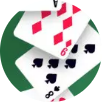Danger in the sea
Environmentalists on the hunt for ghost nets with AI
Lost fishing nets are to be better tracked down in the oceans in future with the help of artificial intelligence. The new technology can automatically evaluate sonar images of the seabed and mark places where such ghost nets are likely to be found, according to the environmental protection organization WWF Germany.
The WWF is working together with the companies Accenture and Microsoft. Together, they launched the AI-supported online platform GhostNetZero.ai, which research institutes, authorities and wind power companies can use to donate suitable sonar data. These recordings would be collected anyway, for example to safeguard shipping traffic or for wind turbines.
Net parts, lines, ropes, hooks, fish traps
Ghost nets are all gear that is released into the sea from fishing vessels. In most cases, these are not complete nets that end up floating in the sea, but only the remains of nets, lines, ropes or bait hooks. Fish traps and other fishing cages are also included.
A few years ago, Australian researchers calculated that around two percent of the fishing gear used worldwide ends up in the sea every year, i.e. tens of thousands of square kilometers of gillnets and purse seine nets, plus hundreds of thousands of kilometers of longlines.
The WWF speaks of 50,000 tons of fishing nets. They would become "deadly traps for fish, seabirds, turtles and marine mammals". They could also damage corals. Over time, the fishing gear breaks down into smaller pieces and fibers.
Hit accuracy already at 90 percent
Such lost equipment materials make up a significant proportion of the plastic waste in the ocean, explained Gabriele Dederer, research diver and ghost net project manager at WWF Germany. "But they are invisible under the surface of the water and are difficult to locate."
WWF has so far recovered 26 tons of ghost nets from the Baltic Sea using its own sonar data. The information now obtained with AI should enable more precise work in the project, which is being carried out together with local fishermen. "We want to set an example for other countries," says Dederer. There is already a lot of technology transfer and joint projects.
The combination of sonar data and AI recognition could substantially improve the search, which was previously carried out manually, says the project manager. "The seabed is mapped all over the world and there are huge amounts of data." If these were evaluated in a targeted manner, much more could be tracked down. The accuracy of the AI is already 90 percent. It is now being trained further to distinguish submarine cables from nets, for example.
This article has been automatically translated,
read the original article here.











Kommentare
Willkommen in unserer Community! Eingehende Beiträge werden geprüft und anschließend veröffentlicht. Bitte achten Sie auf Einhaltung unserer Netiquette und AGB. Für ausführliche Diskussionen steht Ihnen ebenso das krone.at-Forum zur Verfügung. Hier können Sie das Community-Team via unserer Melde- und Abhilfestelle kontaktieren.
User-Beiträge geben nicht notwendigerweise die Meinung des Betreibers/der Redaktion bzw. von Krone Multimedia (KMM) wieder. In diesem Sinne distanziert sich die Redaktion/der Betreiber von den Inhalten in diesem Diskussionsforum. KMM behält sich insbesondere vor, gegen geltendes Recht verstoßende, den guten Sitten oder der Netiquette widersprechende bzw. dem Ansehen von KMM zuwiderlaufende Beiträge zu löschen, diesbezüglichen Schadenersatz gegenüber dem betreffenden User geltend zu machen, die Nutzer-Daten zu Zwecken der Rechtsverfolgung zu verwenden und strafrechtlich relevante Beiträge zur Anzeige zu bringen (siehe auch AGB). Hier können Sie das Community-Team via unserer Melde- und Abhilfestelle kontaktieren.